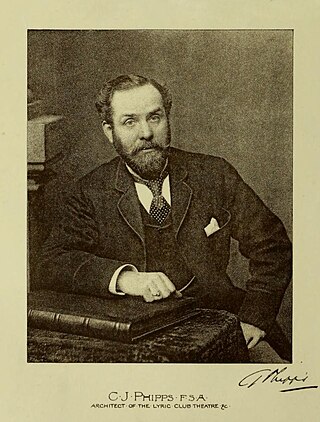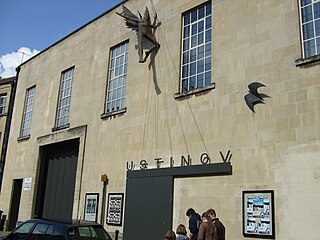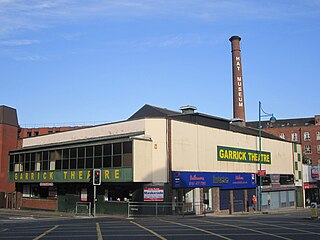
The Royal Opera House (ROH) is a historic opera house and major performing arts venue in Covent Garden, central London. The large building is often referred to as simply Covent Garden, after a previous use of the site. It is the home of The Royal Opera, The Royal Ballet, and the Orchestra of the Royal Opera House. The first theatre on the site, the Theatre Royal (1732), served primarily as a playhouse for the first hundred years of its history. In 1734, the first ballet was presented. A year later, the first season of operas, by George Frideric Handel, began. Many of his operas and oratorios were specifically written for Covent Garden and had their premieres there.

Bristol Old Vic is a British theatre company based at the Theatre Royal, Bristol. The present company was established in 1946 as an offshoot of the Old Vic in London. It is associated with the Bristol Old Vic Theatre School, which became a financially independent organisation in the 1990s. Bristol Old Vic runs a Young Company for those aged 7–25.

The Tennessee Theatre is a movie palace in downtown Knoxville, Tennessee. The theater was built in 1928 in the 1908 Burwell Building, considered Knoxville's first skyscraper. The theater and Burwell Building were added to the National Register of Historic Places in 1982, and the theater was extensively restored in the early 2000s. The Tennessee Theatre currently focuses on hosting performing arts events and classic films, and is home to the Knoxville Opera and the Knoxville Symphony Orchestra. The theater is managed by AC Entertainment.

The Palace Theatre is a theatre Westcliff-on-Sea which is part of the city of Southend-on-sea in the English county of Essex. The theatre presents a range of performances, including drama, music and both local and national touring companies.

The Northcott Theatre is a theatre situated on the Streatham Campus of the University of Exeter, Exeter, Devon, England. It opened in 1967 and was run until 2010 by the Northcott Theatre Foundation, when the company ceased operating after a period in administration. The theatre is now known as Exeter Northcott Theatre and became a registered charity in June 2013.

Mayflower Theatre is a Grade II listed theatre in the city centre of Southampton, England, with a capacity of 2,300. It features West End theatre shows when they tour the United Kingdom. In addition to this, one-off comedy shows and music events often take place at the theatre too.

The Egg is a theatre in Bath, built specifically for the use of young people. It was converted from a former cinema and church hall by architects Haworth Tompkins. The Grade II listed Victorian building houses the eponymous 'egg'-shaped auditorium, around which an arts cafe, rooftop rehearsal space and basement technical workshop are arranged. The idea was supported by the children's author Bel Mooney. It opened in October 2005. In 2007, the Peter Hall Company made use of the space in order to stage a production of George Orwell's Animal Farm.

Charles John Phipps was an English architect known for more than 50 theatres he designed in the latter half of the 19th century, including several important ones in London. He is noted for his design of the Theatre Royal, Exeter, which caught fire in 1887, killing 186 visitors.

The King's Theatre is located in Glasgow, Scotland. It was built for Howard & Wyndham Ltd under its chairman Baillie Michael Simons as a sister theatre of their Theatre Royal in the city and was designed by Frank Matcham, opening in 1904. The theatre is primarily a receiving house for touring musicals, dance, comedy and circus-type performances. The theatre also provides a prominent stage for local amateur productions. The King's Theatre also stages an annual pantomime, produced by First Family Entertainment. The theatre is currently operated by the Ambassador Theatre Group, under a lease from Glasgow City Council who own the building.
The Altrincham Garrick Society was established in 1914 and presents theatrical entertainment of all kinds in its own theatre building in Altrincham, Greater Manchester, England. The main auditorium seats 401 and is in use normally from the end of August to the following July. The society typically produces 12 or 13 mainstage productions per year, as well as 4 or 5 studio productions - these are all amateur productions run to professional standards.

Canberra Theatre Centre (CTC), also known as the Canberra Theatre, is the Australian Capital Territory’s central performing arts venue and Australia's first performing arts centre, the first Australian Government initiated performing arts centre to be completed. It opened on 24 June 1965 with a gala performance by the Australian Ballet.
Haworth Tompkins is a British architecture studio, formed in 1991 by architects Graham Haworth and Steve Tompkins.

Somerset is a county in the south west of England. It has a varied cultural tradition ranging from the Arthurian legends to The Wurzels, a band specialising in Scrumpy and Western music.

The Ustinov Studio is a studio theatre in Bath, England. It is the Theatre Royal's second space, built in 1997 at the rear of the building on Monmouth Street. It is named after the actor Peter Ustinov who led the fundraising programme for the Studio's creation in the early 1990s.

The Marina is a theatre and cinema in Lowestoft, Suffolk, originally opened in the Victorian era. The venue has an auditorium seating 800. It plays host to major West End productions, top comedy, orchestral concerts, touring drama and musical productions, opera, ballet, music, dance and celebrity concerts as well as operating a successful cinema operation - boasting the largest screen and cinema auditoria in the town. The Marina annually hosts the largest professional pantomime on the East Anglian Coast.

Royal & Derngate is a theatre complex in the Cultural Quarter of Northampton, England, consisting of the Royal Theatre, Derngate Theatre and the Northampton Filmhouse. The Royal was built by theatre architect Charles J. Phipps and opened in 1884. Ninety-nine years later in 1983, Derngate, designed by RHWL, was built to the rear of the Royal. Whilst the two theatres were physically linked, they did not combine organisations until a formal merger in 1999; they are run by the Northampton Theatres Trust. The Royal Theatre, established as a producing house, has a capacity of 450 seats and since 1976 has been designated a Grade II listed building; Derngate Theatre seats a maximum of 1,200 and is a multi-purpose space in which the auditorium can be configured for a variety of events including theatre, opera, live music, dance, fashion and sports. The Northampton Filmhouse, an independent cinema built to the side of the complex, opened in 2013.

The Old Orchard Street Theatre in Bath, Somerset, England was built as a provincial theatre before becoming a Roman Catholic Church and since 1865 has been a Masonic Hall. It is a Grade II listed building.

The New Theatre Royal is a Victorian Grade II* listed theatre in the heart of Portsmouth, England, with a capacity of 648. The theatre building was constructed in 1854 as Landport Hall. It was converted to a theatre two years later. It was rebuilt in 1884 by Charles J. Phipps and again in 1900 by Frank Matcham.

Stockport Garrick Theatre is a theatre in Stockport, Greater Manchester, England, founded in 1901 and in 1904 obtained its own premises in Cobden Place, Wellington Street. It is the oldest "little theatre" in the United Kingdom, being defined as being an amateur theatre that owns, leases or otherwise has control of its own premises.

The London Theatre Studio was a drama and design school in Upper Street, Islington, London, from 1936 to 1939. It was directed by the French actor and director Michel Saint-Denis.

























